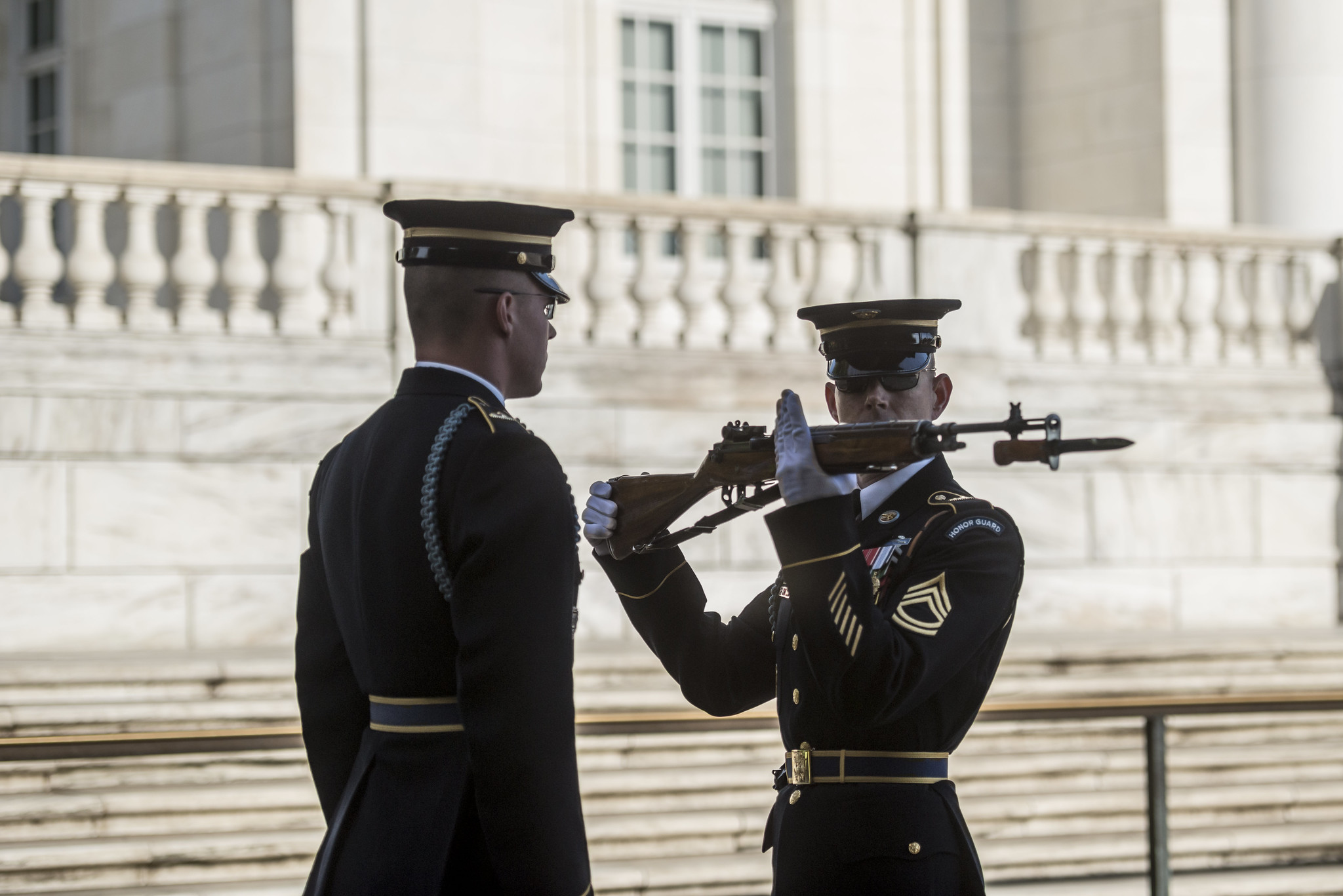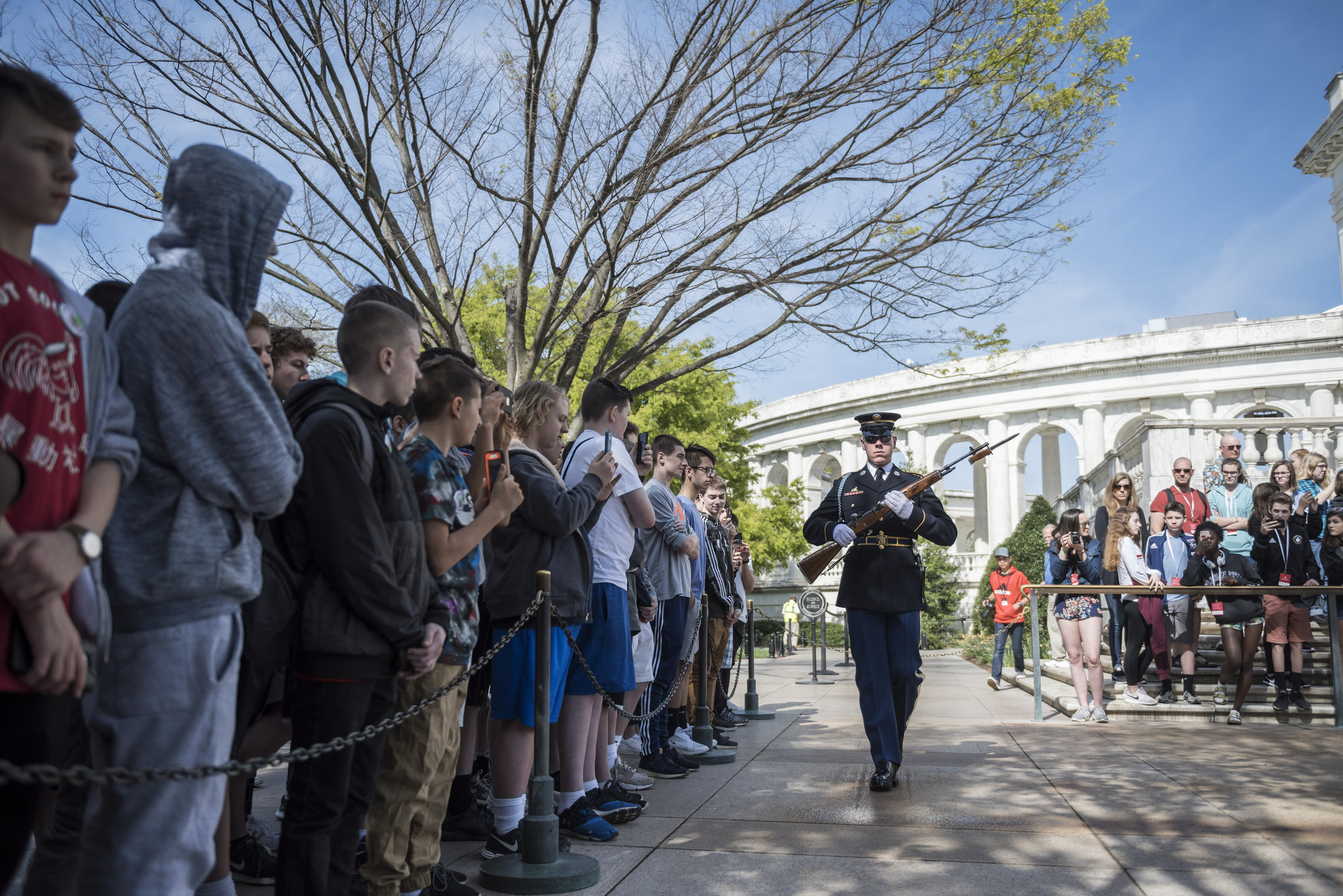Live Camera Feed Tomb of the Unknown Soldier
The Changing of the Guard
The military guard at the Tomb of the Unknown Soldier is changed in an elaborate ceremony which happens every hour on the hour from October 1 through March 31, and every half hour from April 1 through September 30.
Twenty-four hours a day, soldiers from the 3rd U.S. Infantry Regiment, known as "The Old Guard," stand watch over the Tomb. The Tomb Guards, also called Sentinels, are chosen for this prestigious and highly selective post only after rigorous training and a demanding series of examinations (see below). The Old Guard has held this distinguished duty since 1948.
An impeccably uniformed relief commander appears on the plaza to announce the changing of the guard. Soon, the new Sentinel leaves the Tomb Guard quarters and unlocks the bolt of his or her M-14 rifle, signaling to the relief commander to begin the ceremony. The relief commander walks out to the Tomb and salutes, then faces the spectators and asks them to stand and remain silent during the ceremony.
The relief commander conducts a detailed white-glove inspection of the weapon, checking each part of the rifle once. Then, the relief commander and the relieving Sentinel meet the retiring Sentinel at the center of the black mat in front of the Tomb. All three salute the Unknown Soldiers who have symbolically been given the Medal of Honor. The relief commander orders the relieved Sentinel, "Pass on your orders." The current Sentinel commands, "Post and orders, remain as directed." The newly posted Sentinel replies, "Orders acknowledged," and steps into position on the mat. When the relief commander passes, the new Sentinel begins walking at a cadence of 90 steps per minute.
The Tomb Guard marches exactly 21 steps down the black mat behind the Tomb, turns, faces east for 21 seconds, turns and faces north for 21 seconds, then takes 21 steps down the mat and repeats the process. (The number 21 symbolizes the highest military honor that can be bestowed, the 21-gun salute.) Next, the Sentinel executes a sharp "shoulder-arms" movement to place the weapon on the shoulder closest to the visitors, signifying that he or she stands between the Tomb and any possible threat.
When not "walking," the Tomb Guards spend their duty time in quarters below the Memorial Display Room of the Memorial Amphitheater, where they study cemetery history, clean their weapons and help the rest of their relief prepare for the changing of the guard.

Sentinels of the Tomb of the Unknown Soldier
The Sentinels of the Tomb of the Unknown Soldier stand watch 24 hours a day, 365 days a year, in any weather. Sentinels, who volunteer for this post, are considered the elite of the elite 3rd U.S. Infantry Regiment (The Old Guard), headquartered at nearby Fort Myer, Virginia.
After members of the 3rd U.S. Infantry Regiment become ceremonially qualified, they are eligible to volunteer for duty as Sentinels at the Tomb. If accepted, they are assigned to Company E of The Old Guard. Each soldier must be in superb physical condition, possess an unblemished military record and be between 5 feet, 10 inches and 6 feet, 4 inches tall for men or 5 feet, 8 inches and 6 feet, 2 inches tall for women, with a proportionate weight and build.
Would-be Tomb Guards must first undergo an interview and a two-week trial. During the trial phase, they memorize seven pages of Arlington National Cemetery history. This information must be recited verbatim in order to earn a "walk."
If a soldier passes the first training phase, "new soldier" training begins. New Sentinels learn the history of Arlington National Cemetery and the grave locations of nearly 300 veterans.They learn the guard-change ceremony, the manual of arms, and methods for keeping their uniforms and weapons in immaculate condition.
The Sentinels must pass multiple tests to earn the privilege of wearing the silver Tomb Guard Identification Badge. First, they are tested on their manual of arms knowledge, uniform preparation and walks. Then, they take the badge test, consisting of 100 randomly selected questions from the 300 items memorized during training. The would-be badge holder must get more than 95 percent correct.
The Tomb Guard Identification Badge is a temporary award until the badge-holding Sentinel has honorably served at the Tomb of the Unknown Soldier for nine months. At that time, the award can become a permanent badge, which may be worn for the rest of a military career. The silver badge is an upside-down, laurel-leaf wreath surrounding a depiction of the Tomb's front face, the words "Honor Guard," and figures representing Peace, Victory and Valor. Over 600 Tomb Guards have earned the badge since the late 1950s.
The Tomb Guards work on a three-relief rotation; each relief has one commander and about six Sentinels. The three reliefs are organized by height, so that those in each guard change ceremony look similar in appearance. The Sentinels wear the Army dress blue uniform, reminiscent of the color and style worn by soldiers during the late 1800s.
The 3rd U.S. Infantry Regiment
The 3rd U.S. Infantry Regiment, traditionally known as "The Old Guard," is the oldest active-duty infantry unit in the Army, serving the United States since 1784. The Army's official ceremonial unit and escort to the president, it also provides security for Washington, D.C. in times of national emergency or civil disturbance.The unit received its name from Gen. Winfield Scott during a victory parade at Mexico City in 1847, following its valorous performance in the Mexican War. The black-and-tan "buff strap" worn on the left shoulder replicates the knapsack strap used by the unit's 19th-century predecessors to distinguish its members from other Army units.
The Old Guard annually participates in more than 6,000 ceremonies, an average of 16 per day. Despite this arduous schedule, The Old Guard also continuously prepares for its security and infantry missions by conducting year-round training. All soldiers are as familiar with traditional infantry or military-police duties as they are with ceremonial duties.
► More about The Old Guard
Source: https://www.arlingtoncemetery.mil/Explore/Changing-of-the-Guard

Publicar un comentario for "Live Camera Feed Tomb of the Unknown Soldier"